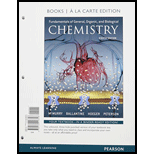
Concept explainers
(a)
Interpretation:
The explanation for skating on ice has to be given based on phase diagram for water.
Concept introduction:
Phase diagrams:
The different phases of a system can be represented in a diagram called a phase diagram. The phase diagram of
Phase diagram of water:
Solid ice is stable at low temperature and liquid water is stable at moderate temperature and high pressure. At high temperature and low pressure, gas phase is the stable one.
(b)
Interpretation:
Skating on dry ice is possible or not has to be determined.
Concept introduction:
Phase diagrams:
The different phases of a system can be represented in a diagram called a phase diagram. The phase diagram of
Phase diagram of carbon dioxide:
At a pressure of
Trending nowThis is a popular solution!

Chapter 8 Solutions
Fundamentals of General, Organic, and Biological Chemistry, Books a la Carte Plus Mastering Chemistry with Pearson eText -- Access Card Package (8th Edition)
- A solution at pH 7 is considered neutral because (a) its hydrogen ion concentration is 0 mol/L (b) its hydroxide ion concentration is 0 mol/L (c) the product of its hydrogen ion concentration and its hydroxide ion concentration is 0 mol/L (d) its hydrogen ion concentration is equal to its hydroxide ion concentration (e) it is nonpolararrow_forwardCarbon dioxide is dissolved in blood (pH 7.4) to form a mixture of carbonic acid and bicarbonate. Neglecting free CO2, what fraction will be present as carbonic acid? Would you expect a significant amount of carbonate (CO32-)?arrow_forwardSketch a diagram of an oxygen dissociation curve indicating the following pH values 7.0, 7.2, 7.4, 7.6 and 7.8 on it.arrow_forward
- Consider the following reaction at 25°C with the ΔG°’ = +1800 J/mol for the forward reaction.The molar concentrations at the beginning of the reaction were [A] = 19 mM and [B] = 10 mM.After 1 hour, the concentrations were [A] = 16 mM and [B] = 13 mM. Calculate the ΔG of the reaction at the 1 hour timepoint. Please round to 1 decimal point.Gas constant = 8.315 J/mol Karrow_forwardThe amino acid alanine has two isomers, α-alanine and β-alanine. When equal masses of these two compounds are dissolved in equal amounts of a solvent, the solution of α-alanine freezes at the lowest temperature. Which form, α-alanine or β-alanine, has the larger equilibrium constant for ionization (HX ⇌ H+ + X−) ?arrow_forwardWhich of the equations below best represents how excess acid in the blood plasma can be removed in the lungs by breathing? H+ (aq) + 0. 2(g) OH + H₂ CO (aq) OH+ + O (aq) 2(g) → H, CO. H + O₂ (aq) 2(g) 3(aq) 3(aq) → H₂O(g) + CO2(g) + CO2(g) → H₂O H, CO3(aq) → HCO, OH t + HCO3(aq) → H₂ CO3(g) → H₂O(g) (aq) → H, CO3(aq) 3 (aq) + CO2(g) H₂O(g) + CO2(g)arrow_forward
- define the equilibrium constant KP for the chemical equilibrium ofideal-gas mixtures?arrow_forwardCalculate the enthalpy of vaporization at the normal boiling point (760 mmHg) of the liquid(water, boiling point of 100 celsius).arrow_forwardWrite balanced ionic equations and net ionic equations forthe following reactions: (a) Aqueous sulfuric acid is neutralized by aqueous potassiumhydroxide.(b) Aqueous magnesium hydroxide is neutralized by aqueoushydrochloric acid.arrow_forward
- Biochemistry: [S] (M) Vo (uM/ min) 2.5 x 10-6 28 4.0 X 10-6 40 1 X 10-5 2 x 10-5 4X 10-5 1 x 10-4 2 x 10-3 1 x 10-2 70 95 112 128 139 140 A) Estimate the values of Km and Vmax from the table (Without using graphs) B) With the table's help, what should be the values in order for an inhibitor that we will insert the system, will inhibit: 1)Competitive? 2)Noncompetitive? 3)Uncompetitive? 4) Irreversible?arrow_forwardWhich of the following correctly explains why the vapor pressure of water has to be included in the calculations? Some of the liquid water evaporates into the gas, and increases the total pressure generated by the trapped gas. As the H2(g) is bubbled up the reaction solution, some of the H2(g) molecules are solubilized by water in the aqueous solution, effectively decreasing the measured pressure above. The pressure contributed by the H2(g) is greater than the measured total pressure because of the contribution of partial pressure of water vapor. The pressure exerted by the evolved H2(g) is reduced because of the co-presence of water vapor, thus Pwater vapor has to be added to Pdry gas. Overview of the experiment:arrow_forwardChemistry CO(g) + 3H2(g) ⇌ CH4(g) + H2O(g) Happens @ 300degrees Celsius The equilibrium concentrations of CO, H2, CH4 and H2O are 12.6 Pa, 7.6 Pa 6.06 Pa and 15.5 Pa respectively. The Kp value is 0.017. a) Determine the value of Kc at 300 °C (Gas constant = 8.315 Pa m3 K-1 mol-1) and calculate the Kp value @ 800 degrees Celsius if the equilibrium concentration of CH4 @ 800 degrees Celsius is 4.6 Pa b) What is the forward reaction exothermic or endothermic? Give a reasonarrow_forward
 Principles Of Radiographic Imaging: An Art And A ...Health & NutritionISBN:9781337711067Author:Richard R. Carlton, Arlene M. Adler, Vesna BalacPublisher:Cengage Learning
Principles Of Radiographic Imaging: An Art And A ...Health & NutritionISBN:9781337711067Author:Richard R. Carlton, Arlene M. Adler, Vesna BalacPublisher:Cengage Learning
